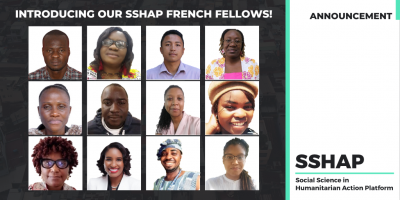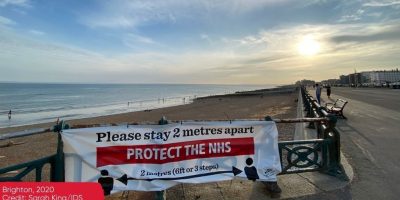Successful vaccine engagement is not just about ‘getting the message right’, but more importantly, about establishing the right relationships with communities. Conventional understandings of community engagement assume that if the experts just get the facts right, identify the ‘right’ messages, and disseminate them widely, people will get vaccinated. These one-directional, top-down communication strategies may succeed in mobilising those who are already vaccine confident and in a position to easily access vaccines. However, they often make little headway with people who are unsure, face structural barriers, and/or who mistrust health services or authority in general. This was a key finding of our recent research on vaccine equity in Marseille and London, funded by the British Academy.
Lack of confidence in vaccination programmes and mistrust of authorities may occur in urban deprived and/or multicultural neighbourhoods Legacies of racism, xenophobia, and inequality, embedded in mainstream culture, social norms and formal policy, can also contribute to a sense among racial/ethnic minorities, migrants, and deprived populations that authorities do not care about them, or may even be trying to harm them. The legacy of mistrust in authorities provides fertile ground for misinformation to gain traction, as nefarious intentions become ‘plausible’ in residents’ eyes. Vaccine hesitancy is also more likely to develop in contexts with high inequality and a lack of citizen participation in decision-making, as the exclusion may lead people to perceive that the state and its partners have malevolent motives for vaccination. Past negative experiences with medical interventions or medical trials can further damage confidence in public health interventions, making people less likely to trust vaccination. For example, in the UK, racialised and minoritised communities, including migrants, have lower access to healthcare, poorer health outcomes, and lower patient satisfaction in clinical settings. In Marseille’s Northern districts for example, residents face daily structural discrimination through a lack of access to transport, healthcare, housing, and schools. Here, mistrust towards public authorities is common.
In multicultural and deprived neighbourhoods especially, local populations are more receptive to interventions that give them a voice, and make them feel heard. Our research suggested that when people are able to speak to authorities they trust about their concerns and priorities, they are more likely to get vaccinated. This helps build trust.
Our research also suggested that creating trust through two-way conversation is best achieved through helplines, Q&A sessions, and safe conversations with doctors in vaccine clinics. The participation in decision-making of community groups and engaged residents is also crucial in establishing relationships of trust. Thus, incorporating their feedback into programming is also critical. Furthermore, relationships between health providers such local doctors, pharmacies and vaccination teams, and members of different community groups require appropriate interpersonal and intercultural skills. Empathetic, non-judgemental, and culturally safe encounters are necessary to build trust. Mediators (community health workers in France who combine health and social work skills, as well as cultural translation) play a role in strengthening these relationships.
Our findings emphasise the importance of developing these relationships with residents from different backgrounds to promote participation. It is important for local government to go beyond conventional notions of community engagement. Here are five other lessons from our research about the implications of building trusting relationships, which are useful when developing future public health interventions:
1) Community engagement by local authorities worked best when the approach was ‘going to’ residents.
Conventional community engagement in local authorities involves opening the doors to community groups and residents through events such as public forums, online town hall meetings, and webinars. These have been useful in the vaccination programme, but it tends to be ‘usual suspects’ – already more engaged community members – who attend. We found that local authorities who identified and engaged with smaller community groups and generated discussions in events already planned by these groups were successful in reaching less engaged residents.
2) At a granular level, there is wide variety in who different social groups trust, and which formats and channels they have most confidence in.
Different people will be perceived as trustworthy by different communities, and this varies depending on the issue. Who communities perceive to be the authority on vaccination (public health specialists, medical doctors, religious scholars, faith leaders and so on) varies on a granular level. Similarly, which channels and formats of health communication are trusted and understood also varies. When health communication teams and community engagement staff in local authorities worked together with community groups to define the vaccine communication strategy (including messages, channels and formats), significant mistakes are avoided.
3) Language barriers and a lack of cultural safety is a key driver of health inequity.
When national and local authorities systematically communicate in the languages people are most proficient in, as well as through official languages, uptake, and trust improves. Recruiting staff and volunteers for the vaccination programme from within communities who speak local languages, and recruiting translators, has also proven to increase uptake. It is not only a process of mechanical translation of communication outputs that is important, but also engaging in ways that create cultural safety, and respect the varying priorities and needs of different cultural groups. When the national authorities in France refuse to carry out this process of translation and cultural safety, many are unable to access vaccination, and may feel discriminated against. The burden of translation is then transferred onto the already overstretched civil society and community groups.
4) Health communication always reflects a moral discourse (whether we are aware of it or not), and communication is most successful when aligned to the existing moral frameworks of target audiences.
Different social groups may respond more readily to health messaging with particular moral underpinnings, which helps to pre-empt concerns or hesitancies. Moral arguments may revolve around autonomy and individual rights, community and social roles, or divinity and the sacredness of life and the body. Different social and cultural groups, and individuals within them, will have different ideas of what is ‘good,’ and what kind of person or community they wish to be. Showing how a vaccine achieves this is a good way to promote vaccination. Furthermore, understanding the lived experiences of others when undergoing vaccination is important: when local authorities create spaces for residents and trusted people in the community to share their experiences of vaccination, feelings of fear and apprehension are mitigated.
5) Health data on social diversity is necessary for effective action, but ‘measuring’ and ‘targeting’ are also politically sensitive practices that must be decided together with racialised and minoritized communities.
In some contexts, such as France, official data (COVID-19 cases, hospitalisations, deaths and vaccination rates) is not broken down by ethnicity or other social dimensions. This makes it difficult to identify or communicate emerging disparities in health outcomes and take swift remedial action. In the UK, having the adequate data broken down by ethnicity allowed for vaccine disparities to be addressed earlier. In settings where such data is available, however, it is important to communicate it sensitively, in order to avoid racism, scapegoating, and stereotyping of populations.
Building relationships with community members in urban deprived and/or multicultural neighbourhoods is difficult due to intersecting challenges, mistrust, and legacies of discrimination. However, these relationships are critical for ensuring that vaccine hesitancy is addressed within groups who need targeting. Our research from Marseille and London have illustrated that public health interventions need to be designed together with the target communities, need to take into account a diversity of opinions and perspectives, and should use up-to-date data and inclusive methodologies.





